
Jean-François de Troy (1679–1752) stands as a pivotal figure in the flourishing French art scene of the early to mid-18th century. A quintessential artist of the Rococo period, De Troy was born in Paris into an artistic dynasty and rose to become one of the most accomplished and versatile painters of his generation. His extensive oeuvre encompasses grand history paintings, intimate genre scenes, elegant portraits, and influential designs for the renowned Gobelins tapestry manufactory. Navigating the complex world of royal patronage, academic hierarchies, and shifting artistic tastes, De Troy carved out a unique niche, particularly through his invention of the tableaux de modes, or "fashion pictures," which vividly captured the sophisticated social rituals of contemporary French aristocracy. His career, marked by both significant triumphs and profound personal loss, offers a fascinating window into the cultural milieu of France during the reigns of Louis XIV and Louis XV.
An Artistic Heritage and Italian Sojourn
Born into the heart of the Parisian art world, Jean-François de Troy's destiny seemed intertwined with painting from the start. His father, François de Troy (1645–1730), was a highly respected portrait painter and, significantly, the director of the prestigious Académie Royale de Peinture et de Sculpture (Royal Academy of Painting and Sculpture). Under his father's tutelage, Jean-François received his foundational artistic training, absorbing the technical skills and academic principles that governed French art at the time. The elder De Troy's success and position undoubtedly provided his son with invaluable connections and an early exposure to the demands of elite patronage.
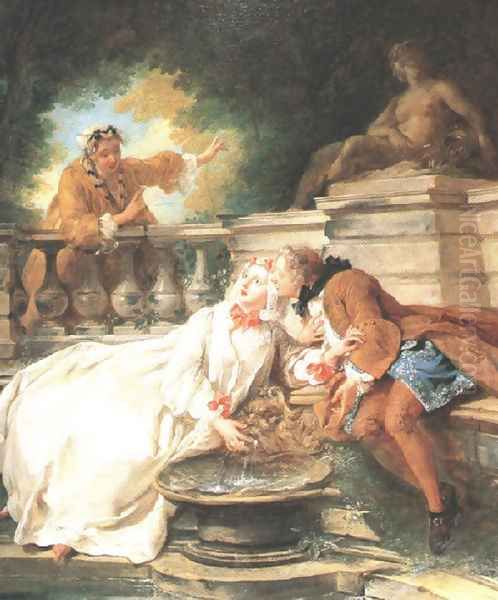
Despite this promising start, Jean-François did not win the coveted Prix de Rome, the Academy's grand prize that funded study in Italy. However, recognizing the importance of Italian influence, his father financed his journey south. From 1699 to 1706, De Troy immersed himself in the artistic riches of Italy, spending a significant portion of this period in Rome. He also likely visited other major centers like Florence and Venice. This extended stay proved formative, exposing him to the masterpieces of the Italian Renaissance and Baroque periods. He absorbed the lessons of the great Venetian colorists, like Titian and Veronese, whose influence would later manifest in the rich palettes and sensuous textures of his own work. The grandeur and dramatic intensity of Italian history painting also left an indelible mark.
Establishing a Reputation in Paris
Upon returning to Paris around 1706, Jean-François de Troy quickly sought to establish his career within the official structures of the French art world. Leveraging his talent and connections, he was accepted (agréé) into the Académie Royale in July 1708 and fully received (reçu) as a member just weeks later, presenting a history painting, likely Niobe and her Children or a similar classical subject, as his reception piece. Membership in the Academy was crucial for securing prestigious commissions, particularly from the Crown and the aristocracy.
De Troy steadily climbed the academic ladder, becoming an assistant professor and later a full professor at the Academy. He participated regularly in the Salons, the official exhibitions organized by the Academy, showcasing his versatility across different genres. His early works demonstrated a mastery of the grand style expected of history painters, tackling biblical, mythological, and historical subjects with technical proficiency and a developing sense of drama. He competed successfully for commissions, gradually building a reputation for reliability and skill, essential qualities for navigating the competitive Parisian art market. His style during this period began to synthesize his French academic training with the lessons learned in Italy, characterized by competent drawing, complex compositions, and an increasing attention to color and light.
The Invention of Tableaux de Modes
Perhaps Jean-François de Troy's most distinctive contribution to Rococo art was his development of the tableaux de modes, or "fashion pictures." Emerging in the 1720s and 1730s, this genre represented a novel approach to depicting contemporary life. While artists like Jean-Antoine Watteau had popularized the fête galante, portraying idyllic outdoor gatherings with a poetic, often melancholic atmosphere, De Troy's tableaux de modes focused specifically on the indoor social lives, fashions, and manners of the French elite. These paintings offered detailed glimpses into the opulent interiors and refined pastimes of the aristocracy.
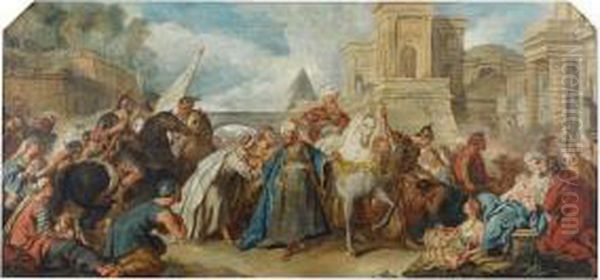
Works such as The Alarm, or the Gouvernante Fidèle (1723), The Declaration of Love (1731), and A Reading from Molière (c. 1728) exemplify this genre. They depict scenes of courtship, conversation, card games, music-making, and intimate meals. De Troy rendered the luxurious fabrics of clothing – silks, satins, velvets – with meticulous detail, capturing the latest trends in fashion. The settings are equally elaborate, showcasing ornate furniture, gilded paneling, mirrors, and works of art, reflecting the sophisticated tastes of his patrons. These paintings were not merely decorative; they functioned as mirrors to the refined, albeit artificial, world of high society, celebrating its elegance, wit, and pursuit of pleasure. They provided a more concrete and less idealized vision of contemporary aristocratic life than Watteau's dreamy visions.
The tableaux de modes proved immensely popular, appealing to patrons who wished to see their own lifestyles reflected and celebrated in art. De Troy's keen observation and ability to capture the subtle nuances of social interaction, combined with his painterly skill, made these works highly sought after. They cemented his reputation as an astute chronicler of his time and a master of the Rococo sensibility, blending elegance with intimacy and a touch of theatricality. This genre distinguished him from many contemporaries and remains one of his most celebrated achievements.
Success in History Painting and Grand Decorations
While the tableaux de modes brought De Troy considerable acclaim, he never abandoned the traditional hierarchy of genres, which placed history painting at the apex. Throughout his career, he continued to produce large-scale works depicting subjects from the Bible, mythology, and ancient history. These paintings were often destined for royal palaces, churches, and the grand homes of the nobility, serving as public demonstrations of erudition, piety, or power. His success in this demanding field underscored his versatility and ambition.
De Troy received significant commissions for decorative schemes at royal residences like Versailles and Fontainebleau. One of his most important projects involved designing cartoons for the prestigious Gobelins tapestry manufactory. Between 1737 and 1741, he created two highly successful series: the Story of Esther (seven panels) and the Story of Jason and Medea (seven panels). These designs, translated into magnificent woven textiles by the Gobelins artisans, were immensely popular and frequently reproduced throughout the 18th century. They showcased De Troy's ability to handle complex multi-figure compositions, dramatic narratives, and rich decorative effects suitable for the grand scale of tapestry.
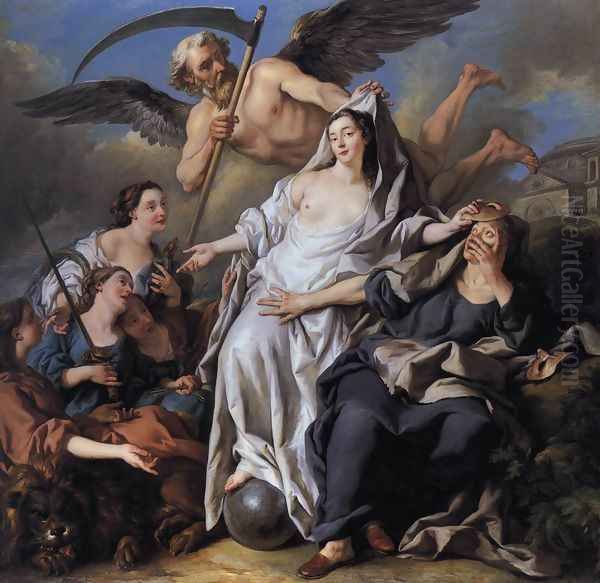
Other notable history paintings include The Triumph of Mordecai (related to the Esther series), Bathsheba at her Bath (c. 1727), and Time Unveiling Truth (1733). In these works, De Troy often employed dynamic compositions, rich, jewel-like colors reminiscent of his Venetian influences, and a palpable sense of drama. He skillfully blended the elegance characteristic of the Rococo with the narrative weight and emotional intensity required by the subject matter. His history paintings confirmed his status as one of the leading French painters capable of undertaking major public commissions, rivaling contemporaries like Charles-Joseph Natoire and Carle Van Loo in this arena.
Portraiture and Decorative Integration
Although Jean-François de Troy is primarily celebrated for his history paintings and tableaux de modes, he was also an accomplished portraitist. Following in the footsteps of his father, François de Troy, a renowned specialist in the genre, Jean-François produced portraits that captured the likeness and status of his sitters with elegance and psychological insight. While perhaps not as central to his oeuvre as other genres, his portraits demonstrate his technical facility and his ability to adapt his style to different demands. He often depicted his subjects within richly detailed settings, integrating the figure with the environment in a manner consistent with his genre scenes.
Beyond individual easel paintings and tapestry designs, De Troy also contributed to larger decorative ensembles, where his paintings were integrated into the architectural settings of palaces and hôtels particuliers (grand townhouses). His ability to tailor his compositions and style to specific spaces made him a valuable contributor to the opulent interiors favored during the Rococo period. These decorative projects often involved collaboration with architects, sculptors, and other craftsmen, reflecting the holistic approach to interior design prevalent at the time. His work in this area further highlights his adaptability and his central role in shaping the visual culture of 18th-century France.
Director of the French Academy in Rome: Honor and Hardship
In 1738, Jean-François de Troy reached a pinnacle of official recognition when he was appointed Director of the French Academy in Rome (Académie de France à Rome). This prestigious position placed him at the head of the institution responsible for training the most promising young French artists who had won the Prix de Rome. As Director, he was tasked with overseeing their studies, guiding their artistic development, managing the Academy's affairs, and representing French cultural interests in Rome. It was a role that demanded administrative skill, diplomatic tact, and artistic authority.
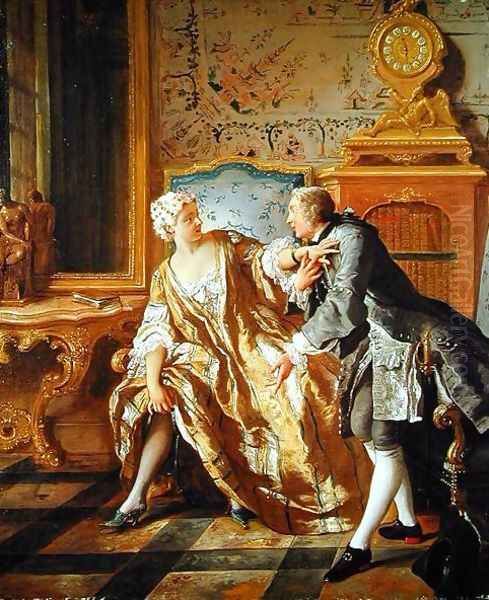
De Troy resided in the Palazzo Mancini, the Academy's seat, from 1738 until his death. His tenure in Rome was marked by a continuation of the lavish lifestyle he had enjoyed in Paris. He entertained frequently, hosting prominent figures from Roman society, visiting dignitaries, and the Academy's students. Contemporary accounts suggest a man who enjoyed the trappings of his success and status. However, this period of professional triumph was overshadowed by profound personal tragedy. His wife, Marie-Anne le Creux (whom he had married in 1709), and all seven of their children predeceased him. This series of devastating losses cast a shadow over his later years, even amidst the splendor of his Roman life.
Despite his personal grief, De Troy fulfilled his duties as Director diligently. He maintained the Academy's standards and fostered an environment where students could study both classical antiquity and the Italian masters. His own artistic production continued, though perhaps at a slower pace. He remained in Rome for the rest of his life, dying there in January 1752. His directorship represented the culmination of a successful career deeply embedded within the French academic system.
Artistic Signature: Rococo Sensibility and Narrative Flair
Jean-François de Troy's artistic style is firmly rooted in the French Rococo, yet it possesses distinct characteristics that set it apart. He masterfully blended the lightness, elegance, and decorative charm typical of the era with a strong narrative sense derived from his training as a history painter. His color palettes are often rich and luminous, showing the clear influence of Venetian painters like Veronese and Titian, whom he admired during his time in Italy. This is particularly evident in his handling of luxurious textiles, where he captured the sheen of silk, the depth of velvet, and the intricacy of lace with remarkable virtuosity.
His compositions vary according to genre. In his tableaux de modes, the arrangements are often intimate and informal, drawing the viewer into the private world of the subjects. Figures are grouped naturally, engaged in conversation or shared activities, creating a sense of immediacy. In contrast, his history paintings and tapestry designs feature more complex, dynamic, and sometimes theatrical compositions, designed to convey dramatic narratives on a grand scale. He possessed a strong sense of rhythm and movement, effectively guiding the viewer's eye through the scene.
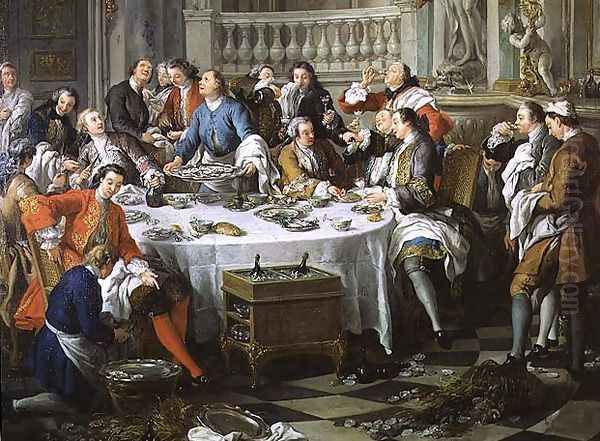
Compared to some of his contemporaries, De Troy's work often retains a greater degree of naturalism and psychological observation, particularly in his genre scenes. While celebrating the elegance of Rococo society, he also subtly captured the nuances of human interaction and emotion. His technical execution was consistently high, characterized by fluid brushwork and careful attention to detail. He successfully navigated the transition from the more formal style of the late Baroque under Louis XIV to the lighter, more intimate aesthetic favored during the Régence and the reign of Louis XV.
A Constellation of Talent: De Troy and His Contemporaries
Jean-François de Troy worked during a particularly vibrant period in French art history, surrounded by a constellation of talented painters who shaped the Rococo era and beyond. Understanding his work requires placing it within this rich context. His career overlapped with, and he often competed against, some of the most famous names in 18th-century French painting.
Jean-Antoine Watteau (1684–1721), though dying relatively young, cast a long shadow with his invention of the fête galante. While De Troy's tableaux de modes shared a focus on contemporary leisure, they differed from Watteau's poetic, often ambiguous outdoor scenes, offering a more direct portrayal of specific social settings and fashions.
François Boucher (1703–1770) became the quintessential Rococo painter, known for his sensuous mythological scenes, pastoral landscapes, and decorative exuberance. Boucher, who eventually succeeded De Troy as Director of the French Academy in Rome (though he declined the post), represented a more overtly decorative and lighthearted facet of the Rococo style.
Nicolas Lancret (1690–1743) was another prominent painter of fêtes galantes and genre scenes, often working in a style influenced by Watteau but sometimes closer to De Troy's more descriptive approach to contemporary life.
Charles-Joseph Natoire (1700–1777) was a major rival, particularly in the field of history painting and large-scale decoration. Like De Troy, Natoire also served as Director of the French Academy in Rome (succeeding De Troy in 1751), highlighting the competitive yet interconnected nature of their careers.
Carle Van Loo (1705–1765) was perhaps the most successful and versatile painter of the mid-century, excelling in history painting, portraiture, and genre scenes. His career trajectory paralleled De Troy's in many ways, demonstrating the possibilities for achieving fame and fortune through the academic system.
Jean-Marc Nattier (1685–1766) specialized in portraiture, particularly known for his flattering allegorical portraits of court ladies, presenting a different facet of Rococo elegance.
In contrast to these painters of aristocratic life and grand narratives stood Jean-Baptiste-Siméon Chardin (1699–1779), a master of still life and intimate scenes of bourgeois domesticity. Chardin's quiet realism and focus on middle-class virtues offered a significant counterpoint to the Rococo extravagance often depicted by De Troy and Boucher.
Other notable contemporaries included the pastel portraitists Maurice Quentin de La Tour (1704–1788) and the visiting Venetian Rosalba Carriera (1675–1757), who captured the likenesses of the era's elite with dazzling immediacy. The older generation of portraitists, Hyacinthe Rigaud (1659–1743) and Nicolas de Largillière (1656–1746), whose grand Baroque style still held sway in De Troy's early career, provided a backdrop against which the newer Rococo styles emerged. History painters like Jean Restout II (1692–1768) and Charles-Antoine Coypel (1694–1752), who was also a playwright and influential academician, further populated this dynamic artistic landscape. Later figures like Jean-Honoré Fragonard (1732–1806), a student of Boucher, would carry the Rococo spirit into the later 18th century, while Jean-Baptiste Greuze (1725–1805) shifted towards sentimental and moralizing genre scenes, signaling changing tastes. De Troy navigated this complex field, borrowing, competing, and innovating to secure his own significant place.
Enduring Legacy
Jean-François de Troy died in Rome in 1752, leaving behind a substantial and varied body of work. His legacy rests on several key contributions. He was one of the most accomplished history painters of his generation in France, successfully undertaking major royal and private commissions, including the highly influential tapestry designs for the Gobelins. His invention and popularization of the tableaux de modes provided a unique and insightful visual record of French aristocratic society during the Rococo period, capturing its fashions, manners, and pastimes with unparalleled detail and elegance.
His long career within the Académie Royale, culminating in his directorship of the French Academy in Rome, underscores his importance within the official art establishment of his time. While perhaps sometimes overshadowed in popular memory by contemporaries like Watteau or Boucher, De Troy's skill, versatility, and innovation secured him a prominent position in 18th-century French art. His work exemplifies the sophisticated taste and artistic excellence of the Rococo era, bridging the gap between grand narrative traditions and the intimate portrayal of contemporary life. He remains a key figure for understanding the complexities and achievements of French painting during the reigns of Louis XIV and Louis XV.